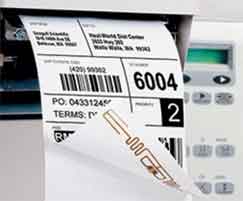It will soon be the 14-year anniversary of the start of Walmart infamous RFID program.
I say "infamous" because not long after the announcement of the program to tag cases and pallets in June of 2003 at a meeting of the VICS retail data standards organization (now part of GS1), the controversy began.
Gilmore Says... |
 |
| If retailers get close to 100% inventory accuracy in their store though item-level tagging, will they really live with lower levels of accuracy further back up the supply chain? |
 |
What do you say? |
 |
| Click here to send us your comments |
|
|
|
Walmart vendors were concerned about the costs of RFID tags and the physical application to the cases, which would have to be done in their distribution centers. Many vendors also questioned where the value was for them, and Walmart gave vague and varying answers to that question.
Manufacturers such as CPG giant Procter & Gamble were bullish on RFID generally, but said the value varied dramatically by product category, whereas Walmart went with a universal, one-size fits all program that aimed to tag all items from every vendor.
After clearly wobbling for several years, with many vendors simply refusing to put on the tags and Walmart clearly unsure of where it was going with the whole thing, the Walmart case tagging project died with hardly a whimper in early 2009, when P&G actually issued a press release stating that after "validating" the benefits of RFID in merchandising and promotional displays, it was ending its pilot program with Walmart for those displays, implying Walmart would not act on the information generated to improve in-store execution.
So all told, did the Walmart program move the RFID in supply chain forward or actually retard its progress?
That's a hard question to answer. Certainly, hundreds of millions or more dollars went from investors to companies developing RFID tags, readers and software, with riches expected from the Walmart RFID goldmine that would certainly appear later as the program expanded at Walmart and moved to other retailers. There is general consensus among those in the industry that that the Walmart program moved the technology forward by many years - even if most of those RFID technology investors in that period lost their shirts in the end.
 On the other hand, many retailers and manufacturers kind of sat back waiting to see how the Walmart program played out. In the US at least, no retailer has initiated a case tagging program since - even though as noted above manufacturers such as P&G and Kimberly-Clark passionately believed there was real value for both manufacturers and retailers for some products and some applications - if the programs were organized smartly. On the other hand, many retailers and manufacturers kind of sat back waiting to see how the Walmart program played out. In the US at least, no retailer has initiated a case tagging program since - even though as noted above manufacturers such as P&G and Kimberly-Clark passionately believed there was real value for both manufacturers and retailers for some products and some applications - if the programs were organized smartly.
Of course, Walmart has dabbled in a so-called "item-level" tagging programs starting in 2010, and other retailers such as first Macy's and more recently Target have announced plans to tag every single items in their stores. Many other retailers are marching down the item-level RFID path.
And I believe it likely that when those programs reach critical mass in terms of the level of items tagged, reader infrastructure rollouts, and of course demonstrated success, it is highly likely that in fact retailers will again turn to case-level tagging - and likely with far better results this time.
If retailers get close to 100% inventory accuracy in their store though item-level tagging, will they really live with lower levels of accuracy further back up the supply chain? I doubt it.
So just maybe we will start to again see RFID case-level tagging in retail before the 20th anniversary of the Walmart program launch we'll reach in 2023, at least in soft goods. Consumer packaged goods may still be a different story.
But you probably couldn't find anybody thinking it would take that long back in 2003.
Any comments on Gilmore's Blog post? Send them in at the form below.
Your Comments/Feedback
|
|
Jim McLean
Consultant, jlmclean Consulting |
Posted on: May, 06 2017 |
|
| We have the tools to take case level tagging to item level tagging in an instant with our Bulk TagLogger system. I will see you at RFID JL in Booth #536. |
|
|